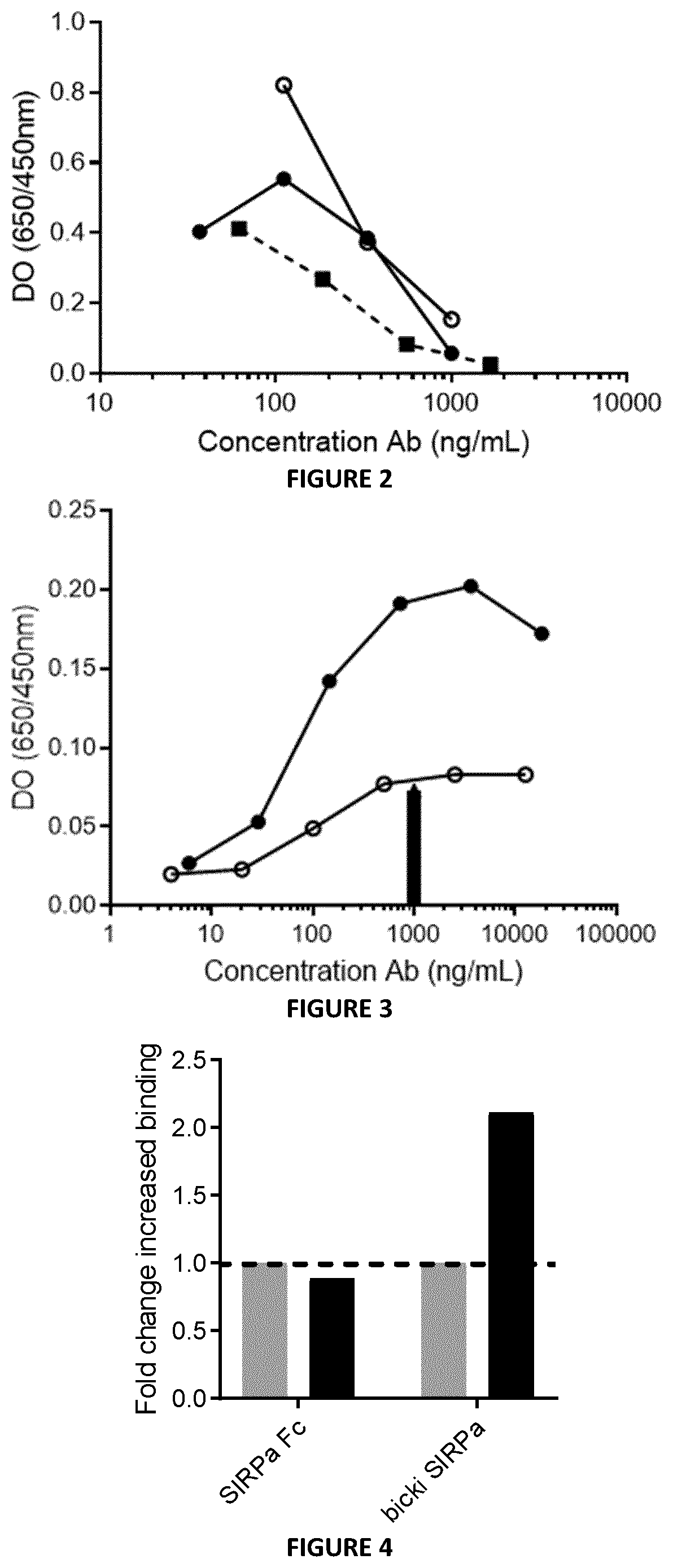Bifunctional Anti-pd-1/sirpa molecule
- Summary
- Abstract
- Description
- Claims
- Application Information
AI Technical Summary
Benefits of technology
Problems solved by technology
Method used
Image
Examples
example 1
the Bifunctional Molecules Anti-PD1-SIRPa on the Binding to PD1 and its Antagonist Capacity on PD1-PDL1 Interaction
[0396]The binding capacity of the Bicki molecules to PD1 recombinant molecule was assessed and the inhibitory efficacy of the Bicki molecules on PD1-PDL1 interaction was performed by ELISA. Results are presented in FIGS. 1 and 2. Bicki anti-PD1-Sirpa molecules where SIRPa is fused to the heavy or the light chain of the antibody does not modify the binding to PD1. Bicki anti-PD1-Sirpa molecules are still capable to inhibit PD1-PDL1 interaction compared to an anti-PD1 antibody alone. No significant difference was observed between Bicki molecules fused to heavy or light chain of the antibody.
[0397]These data were confirmed by surface plasmon resonance experiment (Biacore assay), an anti-human Fc antibody on the sensor chip to capture anti PD-1 alone or the bifunctional molecule were. Then, different concentrations of PD-1 recombinant protein (6.25 to 100 nM) were added to ...
example 2
o CD47 of the Bicki Anti-PD1-Sirpa Molecules
[0398]The binding capacity of Bicki anti-PD1-Sirpa molecules to CD47 (SIRPa Ligand) was assessed by ELISA. Results presented in FIG. 3 show that Bicki anti-PD1-Sirpa molecules conserved their capacity to bind the SIRPa ligand, i.e., CD47. Surprisingly, a higher efficacy has been observed for the Bicki anti-PD1VH-Sirpa molecules compared to the Bicki anti-PD1VL-Sirpa molecule.
example 3
f the Molecule BiCKI SIRPa on T Cells Expressing Both Receptor CD47 and PD1
[0399]The capacity of the BiCKI SIRPa to target T cell by binding both CD47 and PD-1 proteins on the same cells was assessed. Jurkat cells expressing CD47 receptor only or co-expressing PD-1 and CD47 proteins were incubated with the BiCKI SIRPa molecule or SIRPa-Fc molecule. The binding was revealed with an anti-human IgG Fc-PE. FIG. 4 confirms the mechanism of the BiCKI SIRPa acting on the same T cell because the molecule binds with 2-fold higher efficacy to cells expressing CD47+PD-1+ compared to cells expressing only CD47. These experiments demonstrate that the bifunctional Bicki SIRPa molecule is designed to preferentially target CD47+PD-1+ exhausted T cells over other CD47+ cells.
PUM
| Property | Measurement | Unit |
|---|---|---|
| Composition | aaaaa | aaaaa |
| Light | aaaaa | aaaaa |
Abstract
Description
Claims
Application Information
 Login to View More
Login to View More - R&D
- Intellectual Property
- Life Sciences
- Materials
- Tech Scout
- Unparalleled Data Quality
- Higher Quality Content
- 60% Fewer Hallucinations
Browse by: Latest US Patents, China's latest patents, Technical Efficacy Thesaurus, Application Domain, Technology Topic, Popular Technical Reports.
© 2025 PatSnap. All rights reserved.Legal|Privacy policy|Modern Slavery Act Transparency Statement|Sitemap|About US| Contact US: help@patsnap.com



